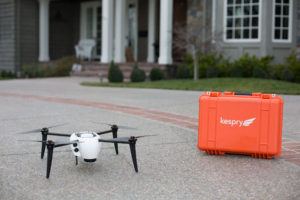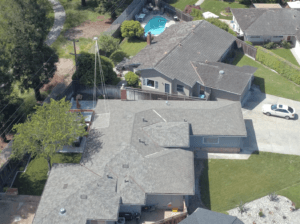Farmers Insurance announced a new microdrone fleet that will assist adjusters on residential roof damage claims in areas impacted by hailstorms and other severe weather events.
The insurer tapped Calif.-based Kespry for the micro UAV quadcopters that weigh 4.4 pounds and can cover up to three properties per hour. The drones provide comprehensive roof dimensions and automated damage detection within minutes.

“The level of accuracy that you’re building a full-scale model that gives you the full dimensionality and the level of damage assessment on a roof is night and day in comparison to a 10 x 10 square which is the standard, call it status quo, in the industry,” said George Mathew, Kespry CEO.
Kespry is also providing training resources, including the education and testing required to obtain a part 107 FAA operator license.
Field tests were conducted over several months to evaluate the best way to use drones to augment the claims process, said Mathew. The drones are automatically instrumented to stay below 400 feet and programed to remain in line of sight. Now the insurer is ready to move on from the pilot project, he said.
According to Tim Murray, head of Inside and National Property Claims for Farmers, catastrophe adjusters along with regional, local adjusters received training in drone operation to become licensed operators. In addition, he said several employees were already licensed operators because of personal drone hobbies.
“We were able to tap into existing folks who actually knew how to handle and fly drones,” said Murray.
Adjusters can autonomously fly the drones, using an iPad application, he added.
The imagery is captured by the drones within minutes and sent to the Kespry cloud where adjusters can pull the information as a report in order to adjust roof claims. The information is also exportable, said Mathew.

Using drones for roof inspections offers several benefits, according to both Murray and Mathew, including faster inspection times, better accuracy and a safer work environment for field adjusters.
“The whole purpose of using this kind of technology is to provide better overall customer experience and really to facilitate a faster process inspection time,” said Murray.
Mathew said leveraging this technology is the future of claims. It can improve productivity, he added.
“The work of an adjuster can literally be scaled up to the point that we see the productivity of adjusters go up as much as four to five times,” Mathew said.
Was this article valuable?
Here are more articles you may enjoy.


 Standard Chartered Settles $2 Billion Iranian Sanction Suit in London
Standard Chartered Settles $2 Billion Iranian Sanction Suit in London  California Again Delays Wildfire Protection Rules for Homes
California Again Delays Wildfire Protection Rules for Homes  Thailand’s Record Floods Paralyze Key Hubs for Tech and Car Parts
Thailand’s Record Floods Paralyze Key Hubs for Tech and Car Parts  How Three New CMS Policies Impact Workers’ Comp Claims
How Three New CMS Policies Impact Workers’ Comp Claims 